Words shape our understanding of the world. Especially in times of Disinformation, we as scholars need to be sensitive about the framing in which we put the knowledge we would like to share. The obstacles of this task become even higher in Digital Humanities. When we write a paper, we might come up with lengthy explanations why something might not be that simple. But a Graph Database such as FactGrid confronts us with the challenge of describing complex, sometimes ambivalent, sometimes contradictory historical realities in a simple statement about certain objects and the relationship between them. In the following, I would like to present some problems, that came across me during a recent research Seminar at Halle University. I will present solutions, that we came up with; hopefully offering a model for others as well. While doing so, I argue that we as scholars should emphasize the importance of a qualitative sensibility for historical realities, even and especially in times, when our discipline is changing towards digital tools and Big Data.
Competing Claims and Composite Rulership
Let’s start with some facts1See my book for the following with more details and additional literature: https://www.degruyter.com/document/doi/10.1515/9783110748727/html: Around the beginning of 1254, Danylo Romanovych was crowned King of Rus’ by a Papal Legate. Danylo was the Duke of Halych-Volhynia, a political entity that came into being after his father Roman Mtislavich in 1199 united the two western principalities (Halych and Volhynia) within the Kyvian Rus (map 1). The Romanovych family would rule over Halych-Volhynia until the beginning of the 14th century. After several decades of power struggles, the region would finally been divided between the Kingdom of Poland and the Grand Duchy of Lithuania around 1366 (map 2). The southwestern parts of the former principality would later (1430/1434) become the Voivodship of Ruthenia within the Kingdom of Poland (map 3).

But how would this story look like if we describe it within certain objects (items) and the relationship (properties) between them? We have two principalities, that were united in 1199. The new entity would then become a kingdom in 1254 and this kingdom would then be divided between the Kingdom of Poland and the Grand Duchy of Lithuania. The Polish parts would become the Voivodship of Ruthenia.

There are certain challenges to this linear narrative: Firstly, the two principalities weren’t united for good in 1199. In fact, when Roman Mtislavich died in 1205, several decades of struggle over the succession within the principalities followed. Secondly, when his son Danylo finally managed to stabilize his rulership and was crowned king, it would not transform the whole principality into a kingdom. The title of “King” was ad personam, as it was with his cotemporary Mindaugas in Lithuania in 1253. So Danylo was practically king, but not over a kingdom and none of his successors would later be called king as well. Thirdly, which date should we give for the transformation of this principality into the Polish voivodship? The area was conquered mostly between 1340 and 1366. It was briefly ruled by the Kingdom of Hungary, whose ruler Louis I would also be crowned King of Poland in 1370. The region was re-integrated into the kingdom of Poland in 1387/89 but it was only almost 50 years later, that the regular voivodship was established.

To complicate matters even further, there was another ruler, who claimed to be king of this area. When the Hungarian King Andrew II secured the principality of Halych-Volhynia for the underaged Danylo, he began to add Rex Galiciae et Lodomeriae (Latin form of Halych-Volhynia) to his royal title. His son Coloman would even be crowned King of Halych-Volhynia in 1216. Even though he was only able to rule in Halych for a couple of years, the title Rex Galiciae et Lodomeriae would be claimed by Hungarian rulers until the early 15th century.
This claim was dormant for centuries but then was brought forth again in the late 18th century when the Polish-Lithuanian Commonwealth was divided between the Empires of Russia, Habsburg, and Prussia. The former voivodship of Ruthenia as well as the southern parts of Lesser Poland reaching until Cracow would be annexed by the Habsburg Monarchy (map 4).

In search of a justification, Austrian legal historians came up with the old Hungarian claims towards Halych-Volhynia, given the fact, that the Empress Maria Theresia was Queen of Hungary as well. Therefore, the annexed territory would be transformed into the so called “Kingdom of Galicia and Lodomeria” (map 5). Ironically, this territory would now include areas, that where never a Rus’ian principality (Lesser Poland with Cracow) but would at the same time miss the whole area of Volhynia, which was never a part of the Polish voivodship of Ruthenia.

To model this complex web of competing claims and composite rules properly poses quite a challenge. Obviously, you can’t describe the relationship between the Principality of Halych to the Principality of Halych-Volhynia with a mere P6 or P7 Property (“Continuation of” / “Continued by”) since it was no stable incorporation. After consulting with Olaf Simons, we agreed on applying the property “Linking back to” (P233 germ. “Entstehungsgeschichtlicher Zusammenhang”) that might be followed by a qualifier to describe this connection to the predecessor (P234), e. g. conquest or merging of rulership (Q704817), a personal union (Q220551) or a mere argumentative recourse (tba). This rather soft description can be used for many cases. To give another example: It would be wrong to say that the Personal Union of Poland and Lithuania after 1385 was succeeding the Kingdom of Poland and the Grand Duchy of Lithuania as both parts would remain distinct political entities at least until the real Union of Lublin 1569. And even afterwards, it was still formally two political bodies under one king with a joint foreign policy.
Following the current approach in FactGrid to avoid reciprocity, the property P233 should only be applied retrospectively, so from the younger backwards to the older entity. As much as I understand the importance of data contingency, I still think, it would also be very helpful to link certain political entities to later ones. In WikiData, this is done through the property P3842 “located in the present-day administrative territorial entity”. In FactGrid, this is sometimes done through the property P742 “Historical continuum”. Here, we should come up with a decision, whether to give this kind of information or not.
Another aspect mentioned was the differentiation between a royal title and a kingdom. It would be misleading to describe the Hungarian King Andrew II as King of Halych-Volhynia. There are some mentions of the so-called Regnum Russiae in the 13th and 14th century in Hungarian sources, but – despite the brief episode of 1370-1387 – there never was a stable Hungarian rulership over the area. The title, that was established during the reign of Andrew II must be characterized as a claim, that he tried to intensify with the coronation of his son but that would ultimately become only a diplomatic leverage. If we use the property “Career Statement” to connect a person with a certain title or office, we should work with a qualifier as well that would describe the usage of this title. I propose to create the property “Legal Character” (Rechtscharakter) to describe the quality behind a certain title. We could then create an item for royal titles, that are merely titular in nature, just as we already have for titular bishops (Q164311).
Bias towards Eastern Europe?
Eastern Europe seems to be particular rewarding for such reflexions since it offers many political entities that wouldn’t correspond to nowadays national states. On the contrary, one and the same premodern political entity can form an important part of different national historical narratives. This is especially visible for the Kyvian Rus’, which forms a contested source of historical identity both in the Russian Federation and Ukraine. But it’s also true for the Polish-Lithuanian Commonwealth, which would be a source of national narratives in Poland and Lithuania, but also in Belarus and Ukraine.2Timothy Snyder, The reconstruction of nations (New Haven, Conn.: Yale Univ. Press, 2003).
But one does not need to stay in Eastern Europe. Speaking of Sweden in the 18th century would mean to refer to an empire that comprised most of the surrounding areas of the Baltic Sea, including Finland, Latvia, parts of Estonia and even Russia.
But somehow, countries in Western or Northern Europe are considered to correspond much easier with contemporary states than in the East. Whereas the FactGrid item for Sweden (Q140553) simply uses the P2-Statement “Country” (Q21925), Ukraine is referred to as “state”, also with the respective P2-Statement “Sovereign State” (Q94416).
Instead of following Putin’s and other’s dark path towards a narrative of more or less “natural” states, we should use these examples as a reminder to differentiate – in analogue writing and in databases – between the different political entities we are describing. Are we talking about the contemporary sovereign state of Poland, are we talking about the Kingdom of Poland as a historical state or are we using the term more broadly to refer to a somehow blurry region? FactGrid already offers such a differentiation for the case of Germany, with different items for the “German Reich”, the “Weimar Republic” or the current “Federal Republic” but also with the item “Germany”, described as “German territories in the longer perspective” (Q140530). Following this model, I created an item for “Russia” to “describe the Russian territories that belonged to different states in a longer temporal perspective” (Q883327). Following the German example, I added the property “Subclass” (P420) to list the distinct political entities (historical and contemporary) that might be described as “Russia”. Here, it is important to stress, that those political entities were never only Russian. Since the expansion of the Grand Duchy of Moscow, this later Tsardom would include various people.3Andreas Kappeler, Rußland als Vielvölkerreich Entstehung – Geschichte – Zerfall (München: C.H. Beck, 2020). It’s so tragic that it took this ongoing war in Ukraine for the German and international public to realise the plurality of the Russian Federation or the Soviet Union. In Russian and German, there is the possibility to differentiate between русский/russkii (germ. russisch) for Russian and российский/rossiiskii (germ. russländisch) for the larger political entity that would include various people.
Summary
In this paper, I raised more questions instead of presenting answers. Premodern political entities are very difficult to describe. That is probably the reason, why FactGrid is still missing a distinct item for the Holy Roman Empire or the Habsburg Monarchy. It’s takes time to develop an idea, how to model these messy and fluid entities. But we should take the time to do it. The shift of Humanities towards Digital Methods is not only about collecting and analysing Big Data. We also must face the challenge of finding a new language to describe historical realities with the same historical accuracy that we would expect from a written paper. Over a hundred years ago, legal scholars of the Habsburg Empire faced similar problems, when they tried to transfer the dynamic political entity of the Habsburg composite rule into a sovereign state and a constitution. Scholars like Georg Jellinek and Hans Kelsen redefined legal theory in order to invent an accurate language to describe the states they lived in.4Natasha Wheatley, The life and death of states. Princeton (N. J.): Princeton University Press, 2023).
Now, we face a similar challenge to transfer historical realities into digital platforms such as FactGrid. One approach I discussed in this paper would be, to define properties, that offer enough flexibility to be applied to various cases and then describe them more precisely through qualifiers. The exchange over such decision in Item Discussions but also through articles like this is crucial. We need come up with a coherent digital language to describe incoherent historical realities.

